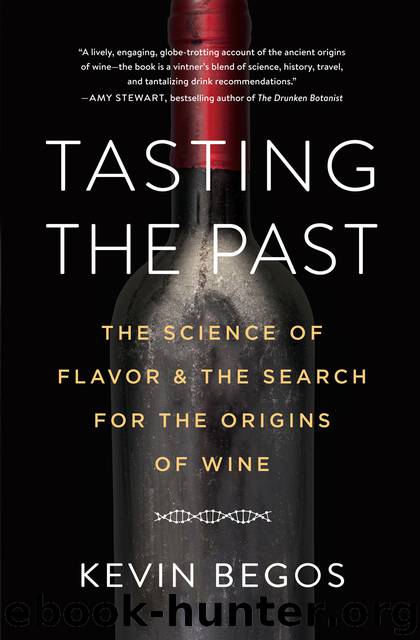Tasting the Past by Kevin Begos

Author:Kevin Begos
Language: eng
Format: epub
Publisher: Algonquin Books of Chapel Hill
Published: 2018-05-25T16:00:00+00:00
11
Italy, Leonardo, and Natural Wine
I’ve drunk Sicilia’s crimson wine!
The blazing vintage pressed
From grapes on Etna’s breast,
What time the mellowing autumn sun did shine:
I‘ve drunk the wine!
—Bayard Taylor, “Sicilian Wine,” 1854
Winemaking first came to Italy about 3,500 years ago, moving west after being established in Greece. Sicily was probably one of the first regions with major production, so I made an appointment to visit Arianna Occhipinti. In an industry filled with seemingly endless profiles of crusty male winemakers, it’s easy to see why many people welcomed a twenty-something woman with a gift for making bright red Sicilian wines with depth, freshness, and a sense of place. Wine magazines sometimes photograph Occhipinti looking like a model, her long, wavy, black hair cascading around a gaze that varies from intense to seductive. For one shoot she perched on a wine barrel with an old limestone wall in the background; in another she bent joyously down in the vineyard dirt, smiling at the camera with youthful exuberance.
I first tried her wines at a Raleigh, North Carolina, tasting—evidence that her fame has spread beyond the major cities on both US coasts. Critics around the world have praised Occhipinti’s wines, which are made with traditional Sicilian grapes such as Nero d’Avola. Her success is part of a trend, too. Italy has done more to identify, protect, and promote local grapes than any other country in the world. Over four hundred varieties are now used to make wine (compared to about ninety in Spain) and regional chefs and food critics promote once obscure varieties such as Cococciola, Dindarella, Pecorino, and Vespolina. The Wine Grapes authors noted that “there are initiatives all over the country to save from extinction and recuperate historic vine varieties that until recently have been known to perhaps only one or two farmers.”
A visit to southeastern Sicily told another part of the story. Driving around country road SP-68 looking for Occhipinti’s vineyard, I saw some healthy vineyards but also barbed wire fences guarding fields of dead vines. There were more than a few old, ruined, stone farmhouses. A stray dog picked through a pile of trash. The region was struggling, not booming. It was a testament to how much Occhipinti had accomplished, more telling than the glossy wine-centric photo ops.
I found her winery behind a stone entrance with remote-controlled iron gates linked to an intercom. Men on heavy equipment were working on a new white-walled storage structure. A perfectly renovated farmhouse with limestone walls and a terra-cotta roof stood next to a new winery building.
Occhipinti was sixteen when her uncle Giusto took her to the 2000 Vinitaly wine expo. Giusto was a pioneer, too, co-founding COS winery in the 1980s, which emphasizes local grapes and ferments them in clay amphora. It’s one of the largest attempts at recreating ancient winemaking styles in the world. Occhipinti loved the people at Vinitaly and the nonstop wine discussions, and she soon joined the University of Milan’s winemaking program. But many of the courses there stressed laboratory work and industrial wine production, and Occhipinti rebelled.
Download
This site does not store any files on its server. We only index and link to content provided by other sites. Please contact the content providers to delete copyright contents if any and email us, we'll remove relevant links or contents immediately.
A Court of Wings and Ruin by Sarah J. Maas(7727)
The Death of the Heart by Elizabeth Bowen(3578)
The Sprouting Book by Ann Wigmore(3561)
Better Homes and Gardens New Cookbook by Better Homes & Gardens(3547)
BraveTart by Stella Parks(3414)
Salt, Fat, Acid, Heat: Mastering the Elements of Good Cooking by Nosrat Samin(3119)
Sauces by James Peterson(3071)
Kitchen confidential by Anthony Bourdain(3045)
The Bread Bible by Rose Levy Beranbaum(3036)
Classic by Mary Berry(2976)
Solo Food by Janneke Vreugdenhil(2945)
Ottolenghi - The Cookbook by Yotam Ottolenghi(2897)
Martha Stewart's Baking Handbook by Martha Stewart(2825)
Day by Elie Wiesel(2745)
Betty Crocker's Good and Easy Cook Book by Betty Crocker(2697)
The Plant Paradox by Dr. Steven R. Gundry M.D(2581)
My Pantry by Alice Waters(2576)
The Kitchen Counter Cooking School by Kathleen Flinn(2499)
Hot Sauce Nation by Denver Nicks(2466)
